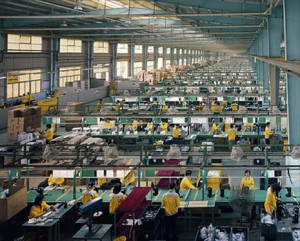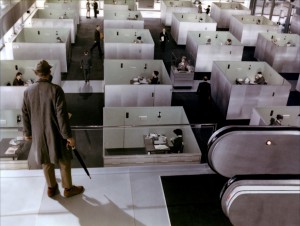
Manufactured Landscapes and the Guilty Conscience
Manufactured Landscapes and the Guilty Conscience
Ever since the 18th century, architects, city planners, and landscape architects have taken a position on industrialization and its resulting constructs. From projects and proposals embracing industrialization to those rejecting it, it is clear that “the city itself is considered a product of industrialization (capital and production flows), that does not simply begin or end, but evolves to affect city form and function in various ways.”1 However, we are now truly beginning to feel the consequential force of the post-industrial world – consequences which extend not only to the ground but also to the mind and the body. These conditions are represented in Edward Burtynsky’s landscape photography, as well as the documentary film Manufactured Landscapes by Jennifer Baichwal.
Industry, architecture, and man are intertwined, as suggested by Burtynsky’s photographic shots of the Chinese factory workers (Fig. 1) which call to mind the office scene from Jacques Tati’s 1967 film Playtime (Fig. 2). Also captured from an overhead aerial view, Tati’s office scene depicts the monotonous, sterile quality of a seemingly endless grid of cubicles. This is a commentary on the conditions of modernity manifested in the workplace, along with the rise of advanced technologies leading to increasing standardization and repetition. There are several distinctions between Tati’s scene and Burtynsky’s photographs, however, which make clear the difference in time and location. Tati’s scene depicts a proliferation of several internally directed units that are spatially demarcated by a separation of circulation. This symbolizes the societal segmentation of the times, and also represents the divisions of labor, giving the illusion of private space within a collective whole. Burtynsky’s factory photographs eliminate this privatization and separation entirely. The photographs, as well as Baichwal’s opening scene, show an interminable continuity of a free plan without vertical separation aside from the steel trusses that frame the aircraft hangar-esque factory. Additionally achieved in the film is a rhythmic repetition as the camera moves steadily down the aisles of workers, which visually emphasizes the tedium of the working conditions.
Here it is obvious that the individual is no longer privileged, and is instead reduced to one of many, a mere dot of color in the scene. The work force as a whole now becomes more important than any one employee. This is visually represented by the identical uniforms, united in one single color. The striking yellow outfits, for example, especially evoke the imagery of a hive of bees, diligently working at maximum speed and efficiency. In this respect, China has not only achieved mechanized production of goods and products, but also a mechanization of the human condition. The factory in China has turned the human body itself into a vessel for production, predicated on the repetitive and the ritualized. One may reasonably argue that after assembly of 2,000+ widgets a day, the act becomes engrained in muscle memory, freeing resources of the mind. One must be careful not to let the mind wander too far though, as a slip in concentration could cause dire consequences. This control through repetitive action causes the human to sink into a tedious malaise, a mechanized state, no longer man but drone.
As Burtynsky would argue, man and nature are inseparable (specifically the trinity of mind, body, and nature). While Burtynsky makes it clear that he is not out to provide any specific social commentary, his photographs are inherently more objective than the documentary film sets out to be. When one ponders a Burtynsky landscape photograph, for example the lava-like Nickel Tailings of Ontario, or the rolling hills of tire piles, one is struck by a conflicting sensation. On one side, there is a visceral beauty in these scenes that has nothing to do with romanticization of the post-industrial world. On the other side, in spite of our ignorance as to the exact methods of generating such toxic waste, or perhaps because of it, we are guilty for finding beauty in what we know to be harmful. Burtynsky is compelled to show these industrial incursions by what can only be deemed a Kantian impulse to tell the truth, an act in which there is inherent beauty, despite the nature of that truth to be a very ugly reality.
Burtynsky’s photographs can generally be sorted into two types: one being the scarred landscape as a result of extraction or abuse to the land itself, and the other being the junk space built up by detritus left over from industrial production. These categories represent the life cycle of nature and material, which comes full circle in China, where materials both disperse and coalesce. It is also ironic that by recycling metal from circuit boards, toxic waste is actually produced in the process, thus contaminating the water table. Though the damage itself may be irreversible, there are ways to reappropriate the post-industrial wasteland, or “sites of manufacture.”2 One such example is the Maritime Youth House by BIG/JDS in Copenhagen, where a wooden deck was constructed on top of polluted topsoil, creating a hardscaped public zone surrounded on all sides by water. Another reclaimed site is the High Line in Manhattan by James Corner Field Operations with Diller/Scofidio, as well as the remediation of the polluted site in Duisburg-Nord with the Landschaftspark by Peter Latz.
Aside from the reappropriation of damaged sites, another perhaps more prescient architectural opportunity is to stop the problem from proliferating by projecting ahead into the future. This is also what Sanford Kwinter suggests when he advocates the shift of urbanization from being reactive to proactive.3 This includes using clean technologies, as well as technologies to clean. While the interventions are less defined and determined at this point and time, it is clear that we must first evolve our way of thinking. No longer can we be blissfully ignorant of our environmental impact in favor of production. We must take a stand to reunite the artificial and the natural in a productive symbiosis instead of an opposition, and the role of architecture is not only inseparable but essential.
Above – Fig. 1: Cankun Factory, Xiamen City. Burtynsky, 2005
Above – Fig. 2: Office scene. Playtime, Jacques Tati, 1967
—–
Notes
1. Alan Berger, “The Production of Waste” in Drosscape: Wasting land in Urban America (New York:Princeton Architectural Press, 2007), p. 48
2. Niall Kirkwood, “Manufactured Sites: Integrating Technology and Design,” and “New Designs in the Legal Landscape” in Manufactured Sites: Rethinking the Post-Industrial Landscape (London: Routledge, 2001), p. 6
3. Berger, p. 64


